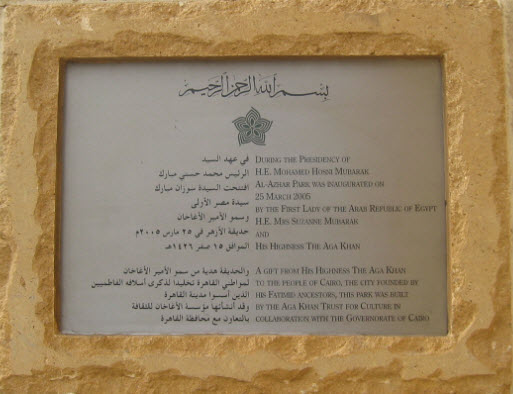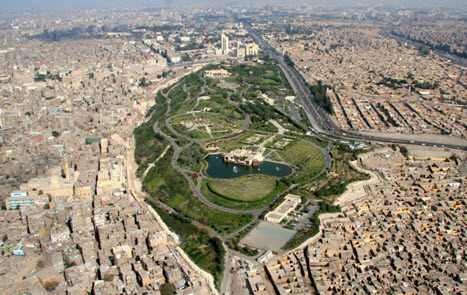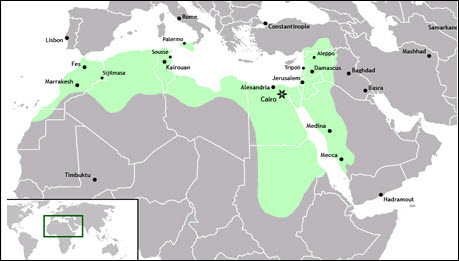
“…we were touching the very foundations of my ancestors, the Fatimids, and the pluralistic history and intellectual profile of this city and this country to which they contributed so profoundly. I am very humbled by the opportunity to return to Cairo, founded over a thousand years ago by the Fatimid Caliph Al-Muizz, to build on that history. Thirty-five generations later, through the work done here by my institutions, it is my prayer that this park will be a continuing contribution to the people of this great city.”
Mawlana Hazar Imam Aga Khan IV, March 25, 2005, Cairo
Speech
On March 25, 2005, Her Excellency Madame Suzanne Mubarak inaugurated the 30-hectare (74-acre) Al Azhar Park in the presence of Mawlana Hazar Imam. After 20 years of planning and construction, the 500-year-old accumulation of fill and debris has been transformed into much-needed leisure and recreational space.

The Park is also a catalyst for social, economic and cultural renewal. What started as one project turned into three: the design and construction of a park, the restoration of the Ayyubid Wall, and the community redevelopment of the historically-important Darb al-Ahmar neighbourhood. Horticulturalists conducted experiments at the American University in Cairo to determine the best plant varieties to use in the Park, where over 665,000 trees, shrubs, succulents, and ground cover were planted.
AKDN Press Release
Fatimids
Named after the Prophet’s daughter, the Fatimids, ancestors of Mawlana Hazar Imam, established their rule in 909 in Tunisia, in North Africa. During their reigns, Imams al-Mahdi and al-Mansur founded the cities of al-Mahdiyya and al-Mansuriyya, named after them. Traces of Fatimid grandeur can still be found in Mahdiyya, including the mosque commissioned by Imam al-Mahdi which continues to be used today after its restoration in the 1960s.
In 973, Imam Al-Mu’izz transferred the dynasty’s capital to a new city in Egypt that he designed. Originally named Mansuriyya after its prototype, it was re-named ‘al-Qahira al-Mu’izziyya’ (‘the Victorious One of al-Mu’izz’), al-Qahira for short, today known as Cairo. Imam al-Mu’izz and his successors patronised intellectual activities, founding institutions of learning, attracting the finest minds to their capital.
Al-Azhar, founded by Imam Mu‘izz in 973 CE, was named in memory of the title al-Zahra (‘the luminous’), which is associated with Fatima, the daughter of the Prophet and the wife of the first Shi‘a Imam, Hazrat Ali, from whom the Fatimids claimed direct descent.

Al-Azhar initially served as a congregational mosque for prayers. Subsequently, a university was established there in 988, soon developing into a major seat of learning with lecture halls and residences for teachers and students, richly endowed to support students and teachers as well as one of the largest libraries of the time in the medieval Muslim world. Al-Azhar became the foremost Fatimid institution of higher learning, with sessions on Qur’anic studies, theology, and law. Admission was open to everyone including women, for whom special classes were organised.
The Dar al-Ilm (‘House of Knowledge’), founded by Imam al-Hakim in 1005, specialised in non-religious sciences such as astronomy, medicine, mathematics, philosophy, and logic. Through the efforts of the Fatimid Caliph-Imams, Cairo became a flourishing centre of scholarship, sciences, art, and culture, in addition to playing a prominent role in international trade and commerce. Cairo also became a major centre for the production of valuable artifacts; furniture and textiles made here had a particularly high reputation and were exported to the entire Mediterranean area.
At its peak, the Fatimid Empire extended from the Atlantic shores of North Africa, across the southern Mediterranean and down both sides of the Red Sea, including Mecca and Medina.

The culture of unhindered scientific thought attracted the finest scholars and artisans of the age to the Fatimid court, regardless of their religious persuasions including astronomer Ali b. Yunus; physicians al-Tamimi and Ibn Ridwan; mathematician Ibn Haytham, “father of optics” who was known in Europe by the Latin name Alhazen. The foundation of contemporary advances in the study of light, optics, and ophthalmology are based upon al-Haytham’s observations and findings.
The Fatimids were noted for employing their officers based on merit rather than on heredity. Halm states that “the priority accorded to the intellect by the Fatimids was intentionally pluralistic and meritocratic, open equally to all Muslims, Ismailis and others, Christians and Jews, enabling the original thinker, creative scientist or talented poet, as much as the astute politician and military strategist, to rise high in the offices of court and state.” Hence, the concepts of knowledge society, meritocracy, and pluralism were well expressed in the Fatimid state.
The reign of the Fatimids for almost two centuries, is often referred to as a ‘golden age’ in Ismaili history, but also “one of the greatest eras in Egyptian and Islamic histories, and as such, a milestone in the development of Islamic civilisation” (Daftary, A Short History of the Ismailis, p 66).
Taking its cue from the one-thousand-year-old Al-Azhar “the luminous” University, the Park will bloom for many generations offering a place for peace and contemplation, silently reminding of a dynasty’s contributions to world knowledge and civilisations.
AKDN Video Al-Azhar Project
Sources:
Farhad Daftary, A Short History of the Ismailis, Edinburgh University Press, 1998
Paul E. Walker, Hamid al-Din al-Kirmani, Ismaili Thought in the Age of al-Hakim, I.B. Tauris in association with Islamic Publications Ltd., 1999
Azim Nanji, Al Azhar, The Institute of Ismaili Studies
Heinz Halm, The Fatimids and their Traditions of Learning, I.B. Tauris in association with The Institute of Ismaili Studies, London, 1997
